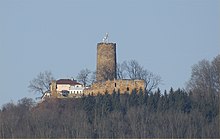Donzdorf sandstone
The Donzdorf sandstone , also called iron sandstone , was quarried in a relatively large area in numerous quarries around Donzdorf near Stuttgart, Aalen and Lauchheim in Baden-Württemberg . It belongs to the iron sandstone formation of the southern German Jura . The iron sandstone formation is dated to the Oberaalenium .
Rock description
This sandstone is clay- ferritically bound, very fine-grained and fine-pored. Its brownish-yellowish color is caused by limonite . Donzdorf sandstone has a strong iron body. It often shows Liesegang's rings and is without a pattern and very uniform. Sometimes there are fine parallel and sloping layers. Ripple marks can be seen on fracture surfaces with the bearing.
mineralogy
Donzdorf sandstone consists of 88 percent quartz , 8 percent rock fragments and 4 percent alkali feldspar. The accessories are muscovite , zircon , tourmaline , rutile , garnet and opaque mineral grains. The grain size averages 0.09 millimeters.
use
This sandstone is only moderately weather-resistant due to its clayey-ferritic bond. When exposed in the open air, it flakes off, while the Liesegang rings withstand weathering better and emerge from the weathering profile.
This regionally and art-historically important stone was used extensively from the 12th century to the beginning of the 20th century. Today this sandstone is no longer being mined. It was mainly used for solid structures (historic churches, castles, palaces), bricks, bridges, window and door frames as well as stairs , crosses and tombs. Due to its fine grain, this sandstone was particularly suitable for stone carving and filigree stone carvings in the Gothic and Baroque styles.
Structures that were built from this sandstone are the Ulm Minster , the town church and the old town hall in Aalen , the Hohenrechberg ruins and the Staufeneck castle ruins and the castle buildings near Donzdorf.
See also
literature
- Wolf-Dieter Grimm: picture atlas of important monument rocks of the Federal Republic of Germany. Published by the Bavarian State Office for Monument Preservation, Lipp-Verlag, Munich 1990, ISBN 3-87490-535-7 .
Individual proof
- ^ Grimm: Monument Atlas of Important Monument Stones. Rock no.116 (see literature)

